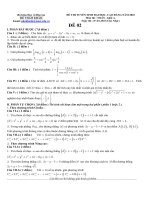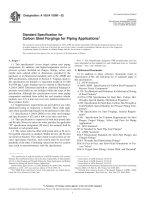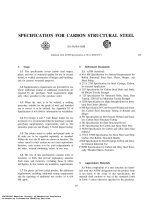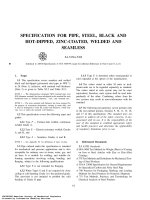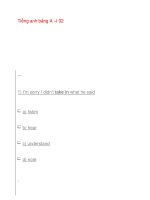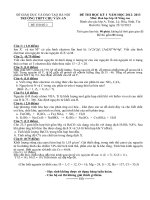Astm a 721 a 721m 02 (2016)
Bạn đang xem bản rút gọn của tài liệu. Xem và tải ngay bản đầy đủ của tài liệu tại đây (65.89 KB, 2 trang )
Designation: A721/A721M − 02 (Reapproved 2016)
Standard Test Method for
Ductility of Oriented Electrical Steel1
This standard is issued under the fixed designation A721/A721M; the number immediately following the designation indicates the year
of original adoption or, in the case of revision, the year of last revision. A number in parentheses indicates the year of last reapproval.
A superscript epsilon (´) indicates an editorial change since the last revision or reapproval.
4.2 This test is applicable to grain-oriented silicon steel such
as covered in Specification A876 in commercial thicknesses
and widths up to 36 in. [910 mm].
1. Scope
1.1 This test method covers determination of the ductility of
grain-oriented silicon steel by use of an apparatus known
variously as a tinner’s brake, hand folder, or an apron brake.
5. Apparatus
1.2 The values and equations stated in customary (cgs-emu
and inch-pound) or SI units are to be regarded separately as
standard. Within this test method, SI units are shown in
brackets. The values stated in each system may not be exact
equivalents; therefore, each system shall be used independently
of the other. Combining values from the two systems may
result in nonconformance with this test method.
1.3 This standard does not purport to address all of the
safety concerns, if any, associated with its use. It is the
responsibility of the user of this standard to establish appropriate safety and health practices and determine the applicability of regulatory limitations prior to use.
5.1 The machine required to perform this test is known
variously as a tinner’s brake, hand folder, or an apron brake.
5.2 The brake shall be at least 36 in. [910 mm] wide with an
opening capacity of approximately 0.035 in. [0.9 mm].
5.2.1 The nose bar shall have a 0.031-in. [0.8-mm] radius.
5.2.2 The bending bar must be movable through an angle of
at least 160°.
5.2.3 The movable table or apron shall move around the end
of the nose bar at a distance of approximately 0.25 in. [6.35
mm].
2. Referenced Documents
2.1 ASTM Standards:2
A34/A34M Practice for Sampling and Procurement Testing
of Magnetic Materials
A876 Specification for Flat-Rolled, Grain-Oriented, SiliconIron, Electrical Steel, Fully Processed Types
E290 Test Methods for Bend Testing of Material for Ductility
6. Test Specimen
3. Summary of Test Method
3.1 A test specimen representing the full width of grainoriented steel to be tested is bent through an angle of about
160° in a tinner’s brake. The number of breaks, or fractures,
occurring along the bend determines the ductility class rating.
6.3 The specimens shall be free of rust, ripples, and
scratches.
6.1 Two specimens are required and they shall be selected
from the same general location as that of the magnetic test
specimens in accordance with Practice A34/A34M.
6.2 The specimens shall be cut transversely to the rolling
direction and have a length equal to the sheet or strip width and
a minimum dimension of 3 in. [80 mm] in the direction of
rolling.
7. Procedure
7.1 The test specimen shall be at a temperature of 25 6 5°C
at the start of the test.
4. Significance and Use
4.1 This is a specialized bend test for grain-oriented steel
not covered under the provisions of Test Methods E290.
7.2 Insert the test specimen into the brake and clamp with
the direction of rolling perpendicular to the nose bar and 0.5 to
1.5 in. [12 to 40 mm] under the nose bar thereby allowing the
balance of the specimen width to rest against the bending bar.
1
This test method is under the jurisdiction of ASTM Committee A06 on
Magnetic Properties and is the direct responsibility of Subcommittee A06.01 on Test
Methods.
Current edition approved April 1, 2016. Published April 2016. Originally
approved in 1975. Last previous edition approved in 2011 as A721/A721M – 02
(2011). DOI: 10.1520/A0721_A0721M-02R16.
2
For referenced ASTM standards, visit the ASTM website, www.astm.org, or
contact ASTM Customer Service at For Annual Book of ASTM
Standards volume information, refer to the standard’s Document Summary page on
the ASTM website.
7.3 Bend the specimen around the nose bar at a uniform rate
by rotating the bending bar through an angle of 160°.
7.4 Remove the specimen from the machine and without
straightening the bend, examine the outside face of the bend for
surface breaks, without magnification.
7.5 Count the breaks and measure for length.
Copyright © ASTM International, 100 Barr Harbor Drive, PO Box C700, West Conshohocken, PA 19428-2959. United States
1
A721/A721M − 02 (2016)
8.3 When the evaluating steel narrower than 24 in. [610
mm], the number of breaks should be multiplied by the ratio of
24 over the strip width in inches. This converted number of
breaks will then determine the class rating.
8. Interpretation of Results
8.1 Classify each test specimen according to length of
number of breaks as shown in the following table which is
based on giving a larger numerical class rating corresponding
to the larger number of breaks and poorer ductility.
Class Rating
Condition of Bend
Class 1
Class 2
no breaks
not more than two breaks with total
length not exceeding 0.5 in.
[12.7 mm]
three to eight breaks, all sizes or fewer
breaks with a total length exceeding 0.5 in. [12.7 mm]
nine to fifteen breaks, all sizes
more than fifteen breaks, all sizes
Class 3
Class 4
Class 5
8.4 The class rating assigned to a test lot shall be the higher
numerical class number of the two specimens.
9. Precision and Bias
9.1 It is not practicable to specify the precision of the
procedure in this test method because the test result is a
classification (not a numeric value). The procedure in this test
method has no bias because the ductility classification is
defined only in terms of this test method.
10. Keywords
8.2 The class ratings shown are based on strip widths of 24
to 36 in. [610 to 910 mm].
10.1 ductility; electrical; grain-oriented; silicon; steel
ASTM International takes no position respecting the validity of any patent rights asserted in connection with any item mentioned
in this standard. Users of this standard are expressly advised that determination of the validity of any such patent rights, and the risk
of infringement of such rights, are entirely their own responsibility.
This standard is subject to revision at any time by the responsible technical committee and must be reviewed every five years and
if not revised, either reapproved or withdrawn. Your comments are invited either for revision of this standard or for additional standards
and should be addressed to ASTM International Headquarters. Your comments will receive careful consideration at a meeting of the
responsible technical committee, which you may attend. If you feel that your comments have not received a fair hearing you should
make your views known to the ASTM Committee on Standards, at the address shown below.
This standard is copyrighted by ASTM International, 100 Barr Harbor Drive, PO Box C700, West Conshohocken, PA 19428-2959,
United States. Individual reprints (single or multiple copies) of this standard may be obtained by contacting ASTM at the above
address or at 610-832-9585 (phone), 610-832-9555 (fax), or (e-mail); or through the ASTM website
(www.astm.org). Permission rights to photocopy the standard may also be secured from the Copyright Clearance Center, 222
Rosewood Drive, Danvers, MA 01923, Tel: (978) 646-2600; />
2
